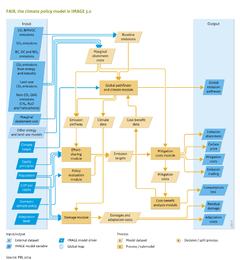Climate policy
| Component is implemented in: |
|
| Related IMAGE components |
| Models/Databases |
| Key publications |
| References |
Key policy issues
- What global greenhouse gas emissions pathways would meet the well below 2 °C climate target?
- What is the effect of effort-sharing approaches on regional and national emission reduction targets and on the cost of climate policies?
- What is the effect of the NDCs on achieving the long term 2 ºC target?
- What are the trade-offs between mitigation costs, adaptation costs, and climate change damage?
Introduction
Model description of Climate policy
With the 2015 Paris Agreement, all Parties to the United Nations Framework Convention on Climate Change (UNFCCC) have agreed to limit global warming to 2 °C compared to pre-industrial levels and to pursue efforts to further limit this increase to a maximum of 1.5 °C UNFCCC (2015b).
To achieve this goal, countries have proposed short- and long-term reduction targets in the UNFCCC climate negotiating process and in domestic policies. To support climate policymakers, the IMAGE model is used in conjunction with the climate policy model FAIR. FAIR is a decision support tool to analyse the costs, benefits, and climate effects of mitigation regimes, emission reduction commitments, and climate policies.
FAIR can work in stand-alone mode using exogenous data, but in recent applications it interacts with several IMAGE components. For instance, mitigation cost curves for the energy sector are derived from the Energy Supply and Demand model TIMER and land-use mitigation options from Agriculture and Land Use. Data from FAIR on marginal abatement costs and reduction efforts per sector and greenhouse gases are used as input for IMAGE to evaluate the impacts under different assumptions for climate mitigation.
FAIR in combination with IMAGE can analyse the interaction between long-term climate targets and short-term regional emission targets. Regional targets are based on effort-sharing approaches and/or national emission reduction proposals, taking into account decisions on accounting rules as agreed under the UNFCCC. The central purposes of the model are the calculation of mitigation costs and trade in emission allowances, and the net mitigation costs of a region to achieve its mitigation target. FAIR enables evaluation of proposed effort-sharing regimes, including differentiated timing and participation of a limited number of parties to the climate convention. Furthermore, FAIR analyses the trade-offs between costs and benefits of mitigation and adaptation policy.
